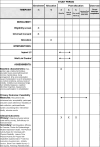A behaviour change intervention promoting physical activity following dysvascular amputation: Protocol for a pilot study
- PMID: 40638625
- PMCID: PMC12244559
- DOI: 10.1371/journal.pone.0326761
A behaviour change intervention promoting physical activity following dysvascular amputation: Protocol for a pilot study
Abstract
Background: Diabetes-related lower limb amputation (LLA) is a leading cause of disability globally, impacting individuals' physical and mental health, and ultimately their quality of life. Physical activity can reduce risk of chronic disease and mortality while improving quality of life. However, people with LLA often have reduced balance and walking ability resulting in sedentary behaviour. We co-created a physical activity intervention, IMproving Physical Activity through Coaching and Technology following Lower Limb Loss (IMPACT-L3), to support physical activity behaviour change in people with dysvasular LLA. To date, no studies have assessed a peer-led physical activity behaviour change intervention for people with LLA. Prior to launching a large trial, a pilot study is required to assess feasibility and optimize design of a future trial.
Methods: This pilot study is a parallel group randomized controlled trial (RCT) with an embedded qualitative component. The intervention group will have access to once-weekly virtual peer coaching sessions with a peer trained in brief action planning; web-based physical activity modules; and a wearable activity monitor for 8 weeks. The control group will continue usual care and be offered the intervention at the end of the follow-up period. Data on feasibility will be collected including assessment of process, resource, management and treatment indicators. The proposed primary outcomes will be measured at baseline, post-intervention and one month later: total physical activity counts per day measured by the ActiGraphTM activity monitor and self-efficacy measured by the Self-efficacy for Exercise scale. Secondary measures include patient reported outcome measures of physical activity, mobility, depression, social participation, balance confidence and quality of life. Semi-structured interviews will explore feasibility and acceptability of the intervention to participants and peers.
Discussion: This study will inform the design of a definitive RCT to determine the effectiveness of a peer-led physical activity intervention for people with dysvascular LLA.
Copyright: © 2025 MacKay et al. This is an open access article distributed under the terms of the Creative Commons Attribution License, which permits unrestricted use, distribution, and reproduction in any medium, provided the original author and source are credited.
Conflict of interest statement
The authors have declared that no competing interests exist.
Figures
Similar articles
-
Interventions for motor rehabilitation in people with transtibial amputation due to peripheral arterial disease or diabetes.Cochrane Database Syst Rev. 2023 Jun 5;6(6):CD013711. doi: 10.1002/14651858.CD013711.pub2. Cochrane Database Syst Rev. 2023. PMID: 37276273 Free PMC article.
-
Exercise for intermittent claudication.Cochrane Database Syst Rev. 2017 Dec 26;12(12):CD000990. doi: 10.1002/14651858.CD000990.pub4. Cochrane Database Syst Rev. 2017. PMID: 29278423 Free PMC article.
-
A Virtual Self-Management Intervention for Adolescents With Juvenile Idiopathic Arthritis: Protocol for the VISTA-JIA Randomized Controlled Trial.JMIR Res Protoc. 2025 Jun 27;14:e69539. doi: 10.2196/69539. JMIR Res Protoc. 2025. PMID: 40577780 Free PMC article.
-
Does interdisciplinary group care for the treatment of endometriosis improve pain interference: protocol for a pilot randomised controlled trial at an urban academic medical centre.BMJ Open. 2025 Mar 5;15(3):e097372. doi: 10.1136/bmjopen-2024-097372. BMJ Open. 2025. PMID: 40044193 Free PMC article.
-
Exercise interventions and patient beliefs for people with hip, knee or hip and knee osteoarthritis: a mixed methods review.Cochrane Database Syst Rev. 2018 Apr 17;4(4):CD010842. doi: 10.1002/14651858.CD010842.pub2. Cochrane Database Syst Rev. 2018. PMID: 29664187 Free PMC article.
References
Publication types
MeSH terms
LinkOut - more resources
Full Text Sources
Medical



